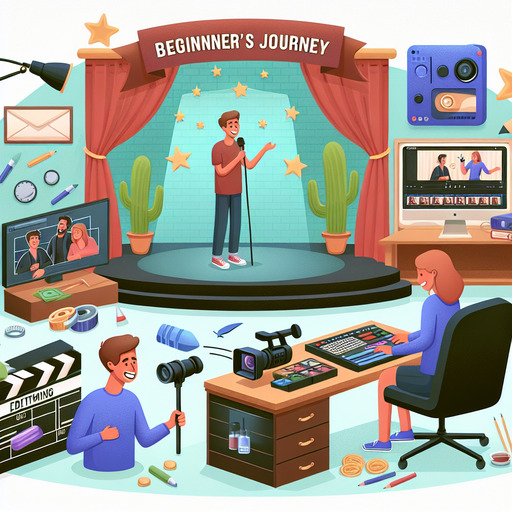
-
Table of Contents
Unlock the Secrets to Stand-Up Comedy Video Editing for Beginners – Click Here to Get Started!
Introduction
Stand-up comedy is an art form that thrives on timing, delivery, and audience engagement. For beginners venturing into the world of video editing for stand-up comedy, understanding the nuances of this genre is crucial. Effective video editing can enhance the comedic impact, ensuring that punchlines land perfectly and the audience remains engaged throughout. This guide will provide essential tips for beginners to master the craft of editing stand-up comedy videos, covering aspects such as selecting the right software, organizing footage, cutting for comedic timing, incorporating audience reactions, and adding finishing touches to create a polished and entertaining final product.
Stand-Up Comedy Video Editing Tips For Beginners: From Recording To Viral Success
Stand-up comedy is an art form that thrives on timing, delivery, and audience engagement. When it comes to translating a live performance into a video format, the editing process becomes crucial in maintaining the essence of the act. For beginners venturing into the world of stand-up comedy video editing, understanding the nuances of this craft can make the difference between a mediocre clip and a viral sensation. The journey from recording to viral success involves several key steps, each requiring careful attention and a strategic approach.
First and foremost, the quality of the initial recording sets the foundation for the entire editing process. Investing in a good camera and microphone is essential. A high-definition camera ensures that the visual quality is crisp, while a high-quality microphone captures the nuances of the comedian’s voice and the audience’s reactions. Positioning the camera at an angle that captures both the performer and the audience can add a dynamic element to the video, making it more engaging for viewers.
Once the recording is complete, the next step is to import the footage into a video editing software. For beginners, user-friendly software like Adobe Premiere Pro, Final Cut Pro, or even iMovie can be excellent starting points. These programs offer a range of tools that can help in trimming unnecessary parts, enhancing audio quality, and adding special effects. It is important to familiarize oneself with the basic functions of the chosen software to streamline the editing process.
Transitioning from raw footage to a polished video involves several critical steps. One of the most important aspects is timing. In stand-up comedy, timing is everything. Ensuring that punchlines are delivered with the right pacing can significantly impact the audience’s reaction. This may involve cutting out pauses that are too long or adding a slight delay to build suspense before a punchline. Additionally, incorporating audience reactions, such as laughter and applause, can enhance the overall viewing experience. These reactions can be strategically placed to emphasize the comedian’s jokes and create a more immersive atmosphere.
Another crucial element is the use of cuts and transitions. Smooth transitions between different segments of the performance can maintain the flow of the video and keep the audience engaged. Jump cuts can be used to remove any awkward pauses or mistakes, while crossfades can create a seamless transition between different scenes. It is important to strike a balance between too many cuts, which can be jarring, and too few, which can make the video feel sluggish.
Adding text and graphics can also enhance the video. Subtitles can make the content more accessible to a wider audience, including those who are hearing impaired or watching without sound. Additionally, incorporating graphics, such as the comedian’s name, social media handles, or upcoming show dates, can provide valuable information to viewers and encourage them to engage further with the comedian’s content.
Finally, the export settings play a crucial role in the video’s final quality. Ensuring that the video is exported in high resolution with the appropriate aspect ratio for the platform it will be shared on is essential. For instance, a video intended for YouTube may require different settings compared to one for Instagram.
In conclusion, editing a stand-up comedy video involves a series of meticulous steps, from recording high-quality footage to fine-tuning the final product. By paying attention to timing, transitions, audience reactions, and additional elements like text and graphics, beginners can create engaging and professional-looking videos that have the potential to go viral. With practice and dedication, mastering these editing techniques can significantly enhance the impact of a stand-up comedy performance in the digital realm.
Q&A
1. **Question:** What are some essential tips for beginners editing stand-up comedy videos?
**Answer:**
– **Focus on Timing:** Ensure that the comedic timing is preserved. Edit to maintain the rhythm of jokes and audience reactions.
– **Use Multiple Angles:** If available, use multiple camera angles to keep the video dynamic and engaging.
– **Highlight Punchlines:** Emphasize punchlines by cutting to close-ups or using reaction shots from the audience.
– **Clean Audio:** Prioritize clear audio. Use noise reduction tools to minimize background noise and ensure the comedian’s voice is clear.
– **Audience Reactions:** Include audience laughter and reactions to enhance the comedic effect.
– **Smooth Transitions:** Use simple cuts and avoid overusing transitions that can distract from the performance.
– **Pacing:** Maintain a good pace by trimming unnecessary pauses and filler content.
– **Graphics and Text:** Use minimal graphics and text to avoid distracting from the performance, but consider adding subtitles for clarity if needed.
– **Color Correction:** Apply basic color correction to ensure consistent lighting and visual quality.
– **Review and Feedback:** Watch the edited video multiple times and get feedback to ensure it flows well and retains its humor.